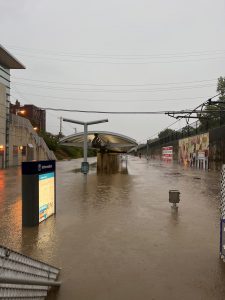Volatile weather across state causing flooding
August 3, 2022
St. Louis streets flooded with a massive storm system that dumped around 11 inches of rain beginning July 26. (Photo courtesy of NWS)
Several significant storms have hit areas of Illinois over the past two weeks, resulting in some major flooding problems.
During the early morning of July 26, Several rounds of thunderstorms with rainfall rates exceeding two inches per hour affected the area along the I-70 corridor in Missouri and I-64 corridor in southwest Illinois.. Upwards of 11 inches of rain fell over the course of roughly eight hours.
More volatile weather is expected over this week, bringing a potential for flash flooding across the state. The Illinois Emergency Management Agency (IEMA) encourages people to keep updated with local forecasts and be prepared for the changing weather patterns.
“Across the state, we are looking at severe thunderstorms and excessive rains that could include hail, damaging winds, and rampant flash flooding,” said IEMA Director Alicia Tate-Nadeau. “This is a good reminder that anywhere it rains, it can flood. We want everyone to be aware of current conditions and be prepared to follow local instructions when severe thunderstorms and flash flooding occurs.”
According to the National Weather Service (NWS), while severe thunderstorms are forecasted for Wednesday, Aug. 3 and Thursday, Aug. 4, parts of Illinois could see widespread flash flooding including parts of central Illinois and southern Illinois. Know the terms used to describe flood threats:
Flood Watch: Flooding or flash flooding is possible. Be extremely cautious when driving, especially at night. Listen to NOAA Weather Radio, commercial radio, or commercial television for additional information.
Flood Warning: Flooding is occurring or will occur soon and is expected to occur for several days or weeks. If advised to evacuate, do so immediately.
Flash Flood Warning: A flash flood is occurring or is imminent. Many smartphones automatically receive flash flood warnings to alert you about flash flooding nearby, even if you are traveling. Flash flooding occurs very quickly, so take action immediately. NEVER drive across a flooded road, especially if the road is closed by barricades.
Flash Flood Emergency: Severe flash flooding resulting in a severe threat to human life and catastrophic damage is happening or will happen soon.

The Forest Park MetroLink station under water after flash flooding hit the St. Louis area beginning in the morning of July 26. (Photo courtesy of NWS)
Other tips from IEMA:
- Purchase a weather alert radio with a battery backup, a tone-alert feature, and Specific Area Message Encoding (SAME) technology that automatically alerts you when a watch or warning is issued for your county. Know the name of the county you live in and the counties you travel through.
- It is critical that someone at home, work, or wherever people gather monitors weather conditions, regardless of the time of day. Monitor watches, warnings, and advisories in your area using a weather alert radio, cell phone app, local TV, local radio, or the Internet. If it is safe to do so, contact family members and friends when you become aware of a flooding situation that may threaten them.
- Check the weather forecast before leaving for extended outdoor periods and postpone plans if flooding is imminent or occurring.
- Make sure family members and friends know how to stay safe. Make a family emergency communications plan and include pets.
- Maintain an emergency supply kit. This kit will help your family cope during extended power outages.
In addition to NOAA weather radios, Wireless Emergency Alerts (WEA) can provide lifesaving information about impending storms and emergencies. These alerts can be sent to your mobile device without the need to download an app or subscribe to a service. Not only are these tools critical to surviving overnight storms, but they can be extremely beneficial for those who travel.
For real-time trusted weather information on severe weather in Illinois:
NWS Chicago: https://www.weather.gov/lot/
NWS Quad Cities: https://www.weather.gov/dvn/
NWS Lincoln: https://www.weather.gov/ilx/
NWS Paducah: https://www.weather.gov/pah/
NWS St. Louis: https://www.weather.gov/lsx/
IEMA’s Severe Weather Preparedness Guide: https://www2.illinois.gov/iema/Preparedness/Documents/severeweatherpreparedness.pdf







